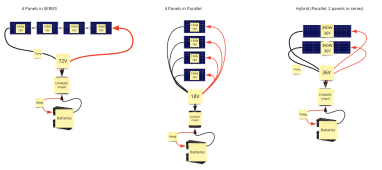ADDvanced
New Member
- Joined
- Sep 6, 2022
- Messages
- 133
So my off grid neighbor built a small cabin, and on the roof he mounted 4 200w Eco-Worthy panels in series, specs are:
His cabin is more wooded than my shed, and gets a lot of partial shade, it might get full sun for maybe 2 hours a day, and he was running a SHITTY charger, I don't know what, but he said it was like $25 on ebay, charging a pair of lead acid batteries.
Well, today he called me, he went back to his place in early afternoon, it was filled with smoke, the chinese charge controller had BURNED UP and melted itself to the wall, melted his battery cables, and melted both his batteries. He did not have a breaker/fuse in between the panels and the charger, but I think what really screwed the pooch was most likely the voltage, as in series that would be 72V, and I'm guessing his cheap ass controller had a max input voltage of 24 or 50volts, I'm not sure.
In any event, everyone is okay, and I said I'd help him design a system that would be a lot safer. So after dealing with Renogy's bullshit, I'm going to push him towards a Victron system since I'm happy with mine, and the app/control has proved extremely beneficial in figuring out what was going on with my batteries, configuring things, monitoring them, etc. So, I mocked up 3 ways to use his panels, keep in mind, most of the time it is partially shaded:

He has no problem adding more wiring, so I was thinking his best bet was probably to run them all in parallel to combat the partial shade. However, he is running a 12v system, so maybe there's more of a benefit to run the hybrid/2 panels in series/parallel approach purely to get the voltage up about 12v earlier/later in the day?
Either way, it seems like a Victron smart charger with a 100V input would work for any of these, I was thinking a 100/30 or 100/50. Would a 100/30 really be limiting him that much? Also, what size breaker would he need going into the charger?
Thank you guys so much for the advice, I am definitely learning a lot and happy to report my system is still online and has been working great.
| Rated Power: 195W | Solar Cell: Monocrystalline |
| Maximum/Peak Voltage(Vmp): 18V | Open Circuit Voltage(Voc): 21.6V |
| Short circuit current: 10.83A | Maximum current: 11.89A |
His cabin is more wooded than my shed, and gets a lot of partial shade, it might get full sun for maybe 2 hours a day, and he was running a SHITTY charger, I don't know what, but he said it was like $25 on ebay, charging a pair of lead acid batteries.
Well, today he called me, he went back to his place in early afternoon, it was filled with smoke, the chinese charge controller had BURNED UP and melted itself to the wall, melted his battery cables, and melted both his batteries. He did not have a breaker/fuse in between the panels and the charger, but I think what really screwed the pooch was most likely the voltage, as in series that would be 72V, and I'm guessing his cheap ass controller had a max input voltage of 24 or 50volts, I'm not sure.
In any event, everyone is okay, and I said I'd help him design a system that would be a lot safer. So after dealing with Renogy's bullshit, I'm going to push him towards a Victron system since I'm happy with mine, and the app/control has proved extremely beneficial in figuring out what was going on with my batteries, configuring things, monitoring them, etc. So, I mocked up 3 ways to use his panels, keep in mind, most of the time it is partially shaded:

He has no problem adding more wiring, so I was thinking his best bet was probably to run them all in parallel to combat the partial shade. However, he is running a 12v system, so maybe there's more of a benefit to run the hybrid/2 panels in series/parallel approach purely to get the voltage up about 12v earlier/later in the day?
Either way, it seems like a Victron smart charger with a 100V input would work for any of these, I was thinking a 100/30 or 100/50. Would a 100/30 really be limiting him that much? Also, what size breaker would he need going into the charger?
Thank you guys so much for the advice, I am definitely learning a lot and happy to report my system is still online and has been working great.



